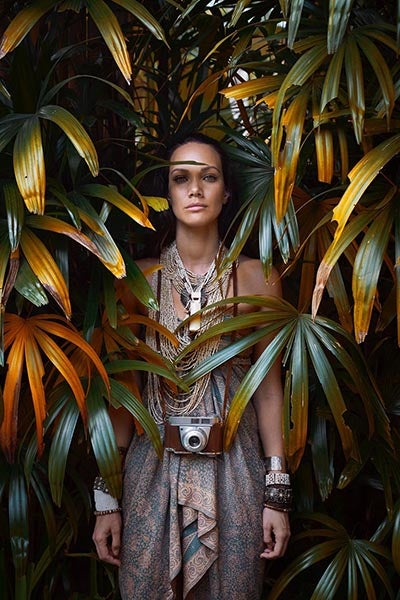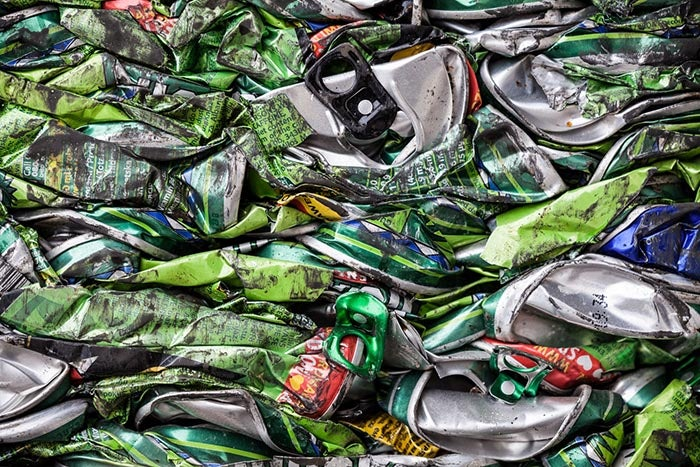Going Natural
How beauty brands celebrate the planet.

Image source: Adobe Stock / EyeEm.
Considering the worldwide COVID-19 health crisis, Earth Day is going to look a little bit different this year. As our environmental, political, and economic landscape has changed drastically over the past few months, so have the ways in which we care for ourselves and others. We are prioritizing global health by staying at home, keeping a social distance, and paying close attention to our mental – and physical – wellbeing. Self-care routines have taken on a new significance, with safety and sustainability kept especially in mind.
Many big-name brands have adjusted their messaging to consumers accordingly – and quickly. More and more advertisements now feature people staying at home, express a greater care for customers during the current situation, and emphasize their dedication to both health and environmental issues. Cosmetic and wellness brands in particular have now reached the stage of going beyond the “do no harm” adage in favor of low-impact and conscious consumerism, minding both the consequences of toxic ingredients on the skin and the environmental damage of the industry at large.
In honor of Earth Day – and the health of all of us – Adobe Stock is examining what is behind some of these trends—without forgetting that, advancement in research aside, minimizing waste is a pressing issue pushed by zero-waste activists and influencers alike.
While labels like “natural” and “organic” do not mean what we think they mean due to lack of regulation within the beauty industry, the industry at large is turning to nature for new, beneficial ingredients. These include plants from the depth of the ocean, mushroom-derived oils and tinctures, and remedies once found only in home cures. These products have gained widespread appeal, but their use of naturally-derived ingredients attract younger consumer groups in particular, as they are channeling their desire for a better world into their purchasing and shopping behavior. These consumers have made it clear that they expect social and environmental responsibility from brands they support, and keep their wallets in line with their beliefs. “Younger consumers identify as citizens as much as consumers and understand the power of using their money to support a brand (or not), explained Brenda Milis, principal of Visual Trends at Adobe. “‘Put your money where your mouth is’ is very much a Gen Z practice.”
This is not the whole picture, though, as Brenda is quick to point out. “There has been a growing movement towards skin-centric cosmetics and grooming in recent years,” she said. “Natural-looking grooming has grown hugely in popularity- people showing their natural skin tone and texture (and therefore taking care of their skin) as they celebrate their looks rather than wearing makeup as a mask.” To take an extended look at this idea, Brenda and her team named one of Adobe Stock’s 2020 visual trends “Makeup is not a Mask.”
Nature to nurture

Image source: Adobe Stock / Alexander Grabchilev / Stocksy.
Nature is a goldmine for nutrient-rich skincare ingredients, and beauty brands are all over it. Consumers are also demanding more ingredient transparency for the products they buy, which, for brands, means they must provide honest, evidence-based information about what they’re using and how. Ingredient labels have gotten a lot more interesting; a current favorite addition is mushrooms, in particular lion’s mane tincture, which is also billed as booster for morning coffee. British make-up artist Charlotte Tilbury added mushroom extract to her “Magic Foundation,” which includes “Concentrated Mushroom Extract, Vitamin C and Hyaluronic Filling Spheres [to] create the look of a plumper-looking, glowing complexion,” according to the product description.
While some are new to the trend, wellness brand Moon Juice has been touting the benefits of mushrooms for a while now. After making them a mainstay in their edible additive “dusts,” mushroom-derived ingredients are now the star of their skincare range “Beauty Shroom.” The principal actor here is tremella fuciformis – or snow mushroom – which can hold 500 times its weight in water. Its merit? It aids cell renewal and prevents the signs of ageing, according to both The Zoe Report and Allure.
The sea is also a rich source of ingredients for skincare and beauty. Caviar extract, squid ink, algae, and byproducts from deep-water fish are ingredients long beloved by the beauty industry, and they have gained a new prominance. Swiss brand La Prairie uses four forms of caviar in their skincare line: absolute, premier, extract, and caviar water, touting caviar as “lifting and firming.” One Ocean Beauty, a company that also focuses on ocean conservation, uses marine-based ingredients like hydrolyzed marine collagen, which is sourced from deep-water fish, and, for their moisturizer, algae extract from the Sea of Japan. Vegan-focused brand Freya and Bailey touts the merits of seaweed, too, as they see it as an alternative way to boost collagen.
Overall, the tendency of companies to “go environmental” caters to the consumer desire for natural and sustainable products that also have powerful, effective ingredients. Along with these natural product lines, companies have started providing their “origin story,” often including a behind-the-scenes look at their production methods and company ethics. Given how actively brands are engaged with Instagram (and its “Stories” feature) to shape the voice of their brand, relying on an ingredient with a compelling narrative has become a go-to marketing technique.
Ancient ingredient, new formula

Image source: Adobe Stock / Colin Anderson / Stocksy.
Seeds, fruits, and plants from all over the world, historically used as home remedies, have morphed into “beauty superfoods,” as trend research group JWT reports.
One of these is the Moringa Tree; native to South Asia, it is known for being one of the most useful trees in the world. It is drought-resistant, yields cooking and lighting oil, and its seeds can be used to purify water. The leaves of the Moringa Tree are rich in calcium, iron, and vitamin A. In the beauty industry, Moringa Tree oil is lauded for being “similar to the oil your skin produces naturally, helping to balance and nourish all skin types,” and for its “antimicrobial” activity, as Allure reported in 2019. UK-based Axiology Beauty uses it in its lip crayons, while Japanese brand Shu Uemura has deep-conditioning hair mask containing Moringa seeds. Kjaer Weis, which launched in 2019, promotes what they term a “Nordic glow,” and uses Moringa as an ingredient in its body oil.
Then there is the Kakadu plum, which is cultivated in the mountainous regions of Australia and is one of the richest sources of vitamin C. It’s also making headlines in the beauty world. “Is Kakadu Plum For Skincare The New Vitamin C?” wonders The Zoe Report, while Refinery29 teases that “This Skin-Care Secret Weapon Is Hiding In Your Produce Aisle.” Kakadu plum appears as a high-priced novelty in American beauty brands (the Dermadoctor Kakadu Vic C Serum retails for $95), but this ingredient is a mainstay in Australian beauty. Local brand Mukti describes the fruit’s properties as “so whizz bang phantasmagorical that it’s in just about all of our facial care range.”
As praiseworthy as it may be to make consumers aware of novel ingredients like the “beauty superfoods” that grow all over the world, not all of them are so new. Consider the trajectory of turmeric, an ages-old home remedy for seasonal colds in Indian households that exploded into a wellness-industry staple. What was once an accessible pantry item rapidly became an expensive fad; Gwyneth Paltrow’s Goop promoted a $48 turmeric-based exfoliating mask made by Kora Organics, while Moon Juice’s turmeric-centric “Cosmic Gold” blend retails for $40.
Minding the water footprint

Image source: Adobe Stock / Breanna Peterson.
As “clean” and earth-friendly as these new beauty products may be, the ingredient that usually comes first on their labels is “aqua” – water. Climate change and water scarcity issues continue to be hot-button issues, and environmentally-conscious beauty brands are hoping to cut down on their water usage in response. Pinch of Colour, a US-based startup founded by Albanian-born Linda Treska, offers a range of “waterless” lipsticks, balms, tints, and face oils. The idea was inspired by Treska’s own childhood, which was marked by periods of water shortage.
Reducing the use of water is not only a matter of concerns over the planet, though; Korean beauty brands are a strong proponent of waterless formulations, which are touted as being richer and more concentrated, as they contain a larger concentration of ingredients. Peach and Lilly’s “The Lotus” line has a lotion made with lotus leaf rather than water, while Whamisa touts a “water cream” made with natto gum.
Take caution, though: even when its label does not indicate aqua as its primary ingredient, a product still relies on water power for packaging, shipping, and the collateral activities involved in a beauty routine.
Zero waste becomes fashionable

Image source: Adobe Stock / Mosuno / Stocksy.
This focus on clean beauty would be a moot point without any attention paid to the staggering impact of product packaging – and what brands are doing about it. The aforementioned Kjaer Weis encourages consumers to make sensible packaging decisions by offering two price points for their inventory, one for loose products, the other for those same product with their boxes, wrapping, and collateral marketing materials.
There are now (Instagram-friendly) brick-and-mortar stores fully devoted to this ethos, too. One of them is aptly named The Package-Free Shop. Its founder, Lauren Singer, first rose to fame in 2012, when she proudly proved to audiences that all the trash she had produced in the past three years fit in a 16-oz mason jar. Singer, also known for her zero-waste lifestyle blog, “Trash is for Tossers,” now has two storefronts in New York City. Her curated inventory runs the gamut from stainless-steel lunchboxes to bamboo toothbrushes to sustainable produce sacks. Beauty products are a big seller at The Package-Free Shop as well; Singer stocks the popular Meow Meow Tweet Deodorant Cream and organic terrazzo soaps from Gem, the latter of which are made from clay, botanicals, and therapeutic-grade essential oils. Singer’s aim? To serve “the typical household — but better,” she says.
Earth Day take-away
As we are concerned for our wellness, we are also concerned for our world – especially right now, as so much depends on our care for health as a whole. A good sign is that we as consumers are gravitating toward products that take this into account.
“The drive in celebrating what is natural and healthy very much aligns skincare’s surge in popularity and the spike in concern and care for our earth and the environment,” said Adobe Stock’s Brenda Milis. “[This] is another reason that using natural, sustainable ingredients in cosmetics is more important than ever before.”